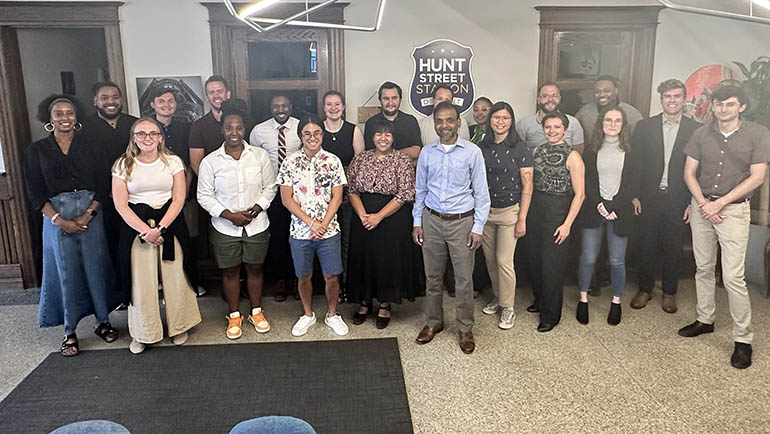
Wayne State urban planning students are mapping out the future of an iconic piece of local artwork with an eye on also preserving its ties to the city’s past.
As a wrap-up to their graduate capstone course, students in the university’s Master of Urban Planning (MUP) program, overseen by the Department of Urban Studies and Planning, on Wednesday gathered at the Hunt Street Station on Detroit's east side to deliver a final planning report aimed at helping to ensure the longevity of the project.
In the report, which was presented to Heidelberg staff and community leaders, students offered a host of environmentally friendly recommendations for the art project that would increase foot traffic at Heidelberg, enhance the staff’s resource capacity and enable the redesigned location to support more programming.
The report caps a weeks-long joint effort between the staff that oversees the colorful, sprawling art installation and MUP students to provide the Heidelberg Project, which is undergoing a transformation, with a fresh framework for fostering change and promoting its mission. The evolution of the Heidelberg Project — a collection of colorfully painted and quirkily decorated abandoned homes and vacant lots along Detroit’s Heidelberg Street — was announced to media five years ago by its creator, artist Tyree Guyton, who said he would slowly dismantle the installation to make way for an as-yet-undetermined “Heidelberg 3.0.”
“I am happy for our students, and I hope they learned a lot about what it is like to work in a professional planning environment,” said Department of Urban Studies and Planning chair Rayman Mohamed, Ph.D., who teaches the capstone course. “(Capstone courses) give students an opportunity to implement what they learned in the classroom in a real-world environment with a real-world client. Also, our classes draw a lot of contexts from Detroit to teach students; capstones in Detroit are a way to give back to the communities that we learn so much from.”
Over this summer, the Heidelberg Project staff and the graduate students from the Department of Urban Studies worked together to consider design proposals for the installation’s properties that would better help the Heidelberg Project team foster community change as the project evolves. The Heidelberg Project began in 1986 when Guyton, in response to the blight spreading throughout his east-side neighborhood, began painting abandoned homes with bright colors and polka dots and festooning them with found objects such as sneakers and stuffed animals.
Although Guyton’s work drew the ire of multiple mayoral administrations — both Coleman A. Young and Dennis Archer demolished portions of the Heidelberg Project at various times — the artist continued to paint more houses and decorate more lots. The Heidelberg Project now attracts scores of visitors every year.
WSU students worked closely with Jessica Brooke Williams, a Master of Urban Planning alumna and interim executive director of the Heidelberg Project, throughout the three-month project to understand the background, objectives, and aspirations of the organization. They also met with staff members to better understand the organization. Throughout the course, the students conducted numerous site visits to The Heidelberg Project to consider how the present and potential future spaces could benefit the project and its residents.
“It was one of the most incredible experiences ever working with the Heidelberg Project,” said Jaylyn King, a student in the MUP program. “This project is so important because it provides invaluable resources to the phenomenal Heidelberg project staff and aids them in building out their capacity and scope of service.”
MUP student Kiki Louya said that the capstone course held special significance for her because she grew up in Detroit.
“As a native Detroiter, I was excited for the opportunity to work with the Heidelberg Project — but I never anticipated how rewarding the experience would be,” Louya said. “At the end, I was not only proud of what we accomplished; I was inspired by each and every one of my classmates. This capstone project really challenges you as a leader. It forces you to check your ego at the door, respect your peers and apply everything you’ve learned in the MUP program in real time. The experience feels so unique to Wayne State University.”
